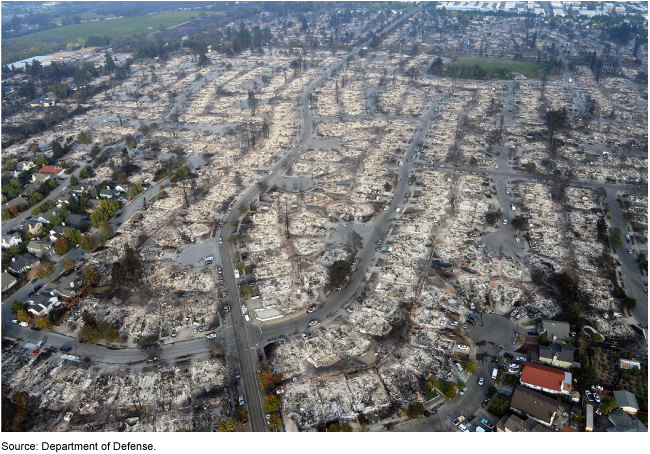Disaster Recovery: Efforts to Identify and Address Barriers to Receiving Federal Recovery Assistance
Fast Facts
Disasters affect hundreds of American communities each year and cause billions of dollars in damage. While federal recovery assistance is available, many disaster survivors face barriers in accessing this assistance.
For instance, small towns and rural areas may lack the resources to effectively manage their recovery efforts. Additionally, lower-income households, individuals who are homeless, and renters sometimes face challenges when trying to participate in federal recovery programs.
We testified that federal recovery programs lack the necessary data and analysis to effectively identify and address such barriers to access.
Aerial Photo of Wildfire Damage, Santa Rosa, California, October 11, 2017

Highlights
What GAO Found
GAO's past work has shown areas where improvements can be made to federal disaster recovery programs to help disaster survivors and state, local, territorial, and tribal governments. While these programs are not typically targeted toward only to low income or vulnerable populations, GAO's prior work and recommendations identified areas that could help these populations. Specifically,
- GAO reported in October 2021 that the Federal Emergency Management Agency's (FEMA) flood mapping investments for fiscal years 2012 through 2020 were lower for communities with higher levels of social vulnerability and underserved populations than communities with lower levels of social vulnerability and underserved populations, other factors being equal. GAO recommended that FEMA better use flood risk data to prioritize flood mapping for vulnerable communities;
- in September 2020, GAO found that disaster survivors, including low-income individuals, faced numerous challenges obtaining aid and understanding the Individuals and Households Program, a FEMA program that provides housing assistance and other needs assistance to individuals affected by a major disaster or emergency. GAO recommended, among other things, that FEMA simplify and streamline the disaster assistance process for survivors;
- in 2019, GAO found that officials from entities that partnered with FEMA reported challenges following the 2017 hurricanes providing assistance to individuals who are older or who have disabilities. GAO recommended that FEMA revise its application process to better serve survivors with disabilities.
FEMA is taking actions to address many of these recommendations.
GAO conducted a literature review as part of its preliminary work and found limited research to describe recovery outcomes and specific characteristics related to participation in the six recovery programs in its review. However, some studies and stakeholder perspectives provided insight. For example, a study of counties in one state found greater levels of flood mitigation in communities with larger tax revenues and greater budgets for emergency management. In addition, officials representing states said small towns and rural areas may lack resources to contract for disaster recovery services. Similarly, representatives from voluntary organizations said that conditions of socioeconomic vulnerability—such as lower-income households or homelessness—may present barriers to participating in federal recovery programs.
GAO's preliminary work found that the six federal recovery programs in GAO's review have taken some actions that could help officials identify and address potential access barriers and disparate outcomes. However, programs lack key information—data and analysis—that would allow them to determine if access barriers and disparate recovery outcomes exist. Moreover, the programs have not taken action to determine (1) the universe of data need to support this kind of analysis and (2) sources and methods to obtain those data when the programs do not already collect them, including overcoming key challenges. GAO will complete its evaluation of the areas above and issue a final report in the coming months.
Why GAO Did This Study
Each year, disasters affect hundreds of American communities and cause billions of dollars of damage. Disaster recovery is a complex process with many factors that affect individual and community outcomes, including in various socioeconomic and demographic groups. Recently, federal actions have focused on equitable administration of federal recovery assistance.
This statement is based on preliminary observations from GAO's forthcoming report on federal actions to identify and address potential access barriers and disparate outcomes, which is currently at FEMA, HUD, and SBA for comment. It also discusses prior GAO work and recommendations issued from 2019 through 2021 related to various federal recovery programs and vulnerable populations.
To develop the preliminary observations, GAO conducted a literature review and interviewed officials at the three federal agencies with historically large disaster recovery programs and reviewed relevant documents. GAO also interviewed recovery stakeholders representing state, local, tribal, and nonprofit interests.
Recommendations
GAO made recommendations to FEMA in prior reports designed to address the challenges in this statement. For example, GAO has made recommendations to FEMA to help disaster survivors navigate the application process and to revise processes to better serve survivors with disabilities. FEMA has taken actions to address many of these recommendations.
